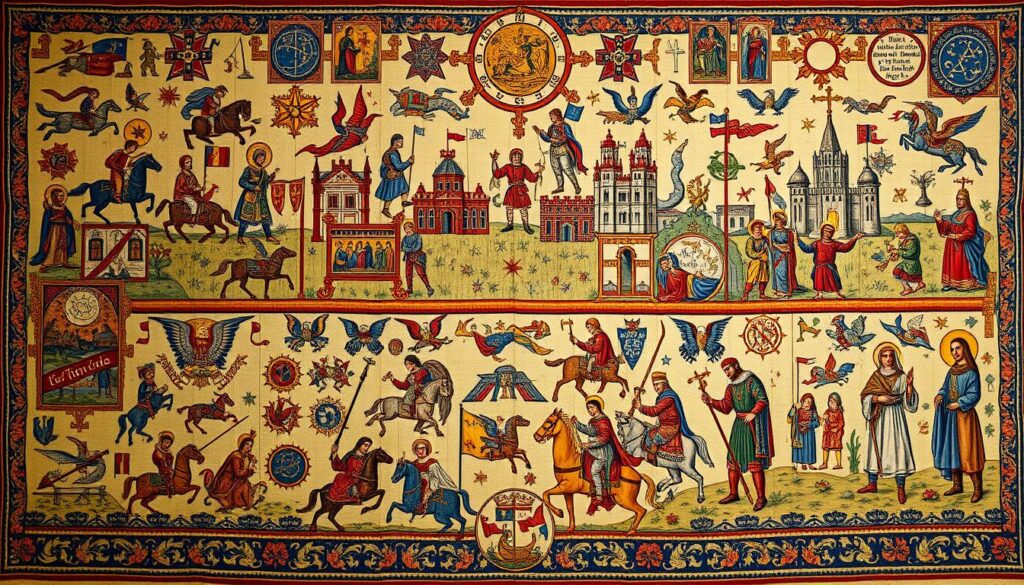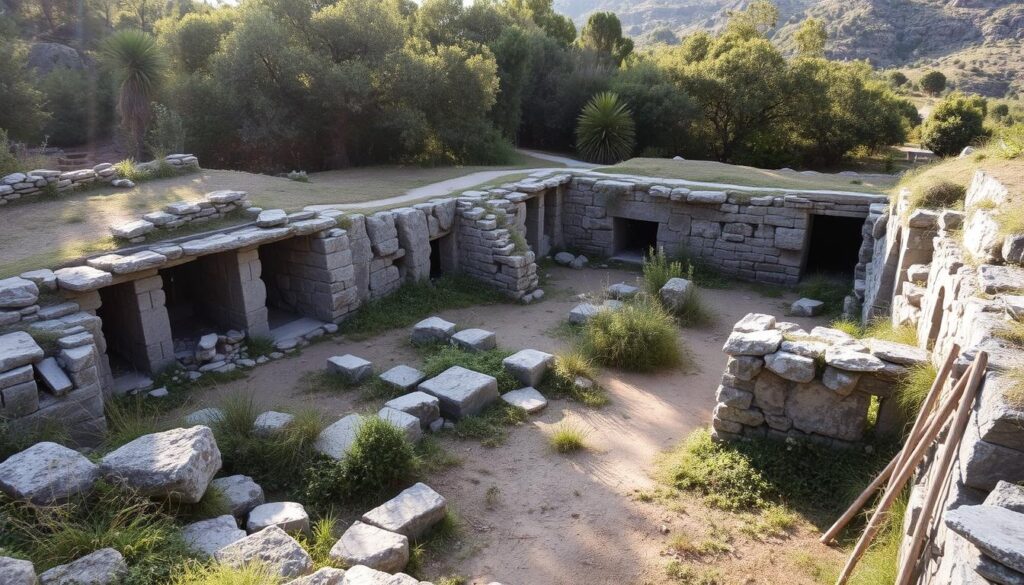German historian Heribert Illig proposed the Phantom Time Hypothesis in 1991. It has sparked a debate about medieval history’s authenticity. This theory claims that the Early Middle Ages, from 614 to 911 AD, was made up. This would mean European history’s timeline is wrong.
The Phantom Time Hypothesis says the year 1000 AD was only 703 years after Jesus’ birth. Illig believes this gap was created by figures like Otto III and Pope Sylvester II. They wanted to add nearly 300 years to history, boosting their power and influence.
This theory is based on seeming gaps in archaeological finds and the difference between the Julian and Gregorian calendars. Illig thinks these were used to fake a longer history. But, historians strongly disagree. They say the theory ignores evidence from other cultures and calendar changes over time.
Understanding the Historical Timeline Controversy
The debate over medieval timelines comes from differences in historical records and dating methods. It looks at key periods and compares old timelines with new ones.
Origins of the Medieval Timeline Debate
The Phantom Time Hypothesis says a big part of recorded history, especially the Early Middle Ages (614-911 AD), might be fake. It suggests a plot to change the calendar, hiding centuries from our timeline.
Key Historical Periods in Question
The hypothesis claims the Early Middle Ages never happened and were made up by historians. It questions the realness of figures like Charlemagne, suggesting they might be fictional to cover up a gap.
Traditional vs Revised Chronology
The Phantom Time Hypothesis believes about 297 years of medieval history, from 614 to 911 AD, were made up. It says this was done to fit important events and support political and religious stories. It points to calendar changes, lack of physical proof, and astronomical records as evidence.
But most historians don’t agree, saying there’s plenty of proof from around the world that supports a real timeline. Archaeological finds and records of astronomical events from the alleged phantom time match up with what we already know, making the theory hard to believe.
| Traditional Chronology | Revised Chronology (Phantom Time Hypothesis) |
|---|---|
| The Early Middle Ages (614-911 AD) are an established period in medieval history. | The Early Middle Ages never existed and were fabricated by later historians. |
| Historical figures like Charlemagne are recognized as real historical figures. | Figures like Charlemagne may have been invented to fill the perceived gap in the timeline. |
| The historical timeline is supported by abundant evidence from Europe and beyond. | Approximately 297 years of medieval history between 614-911 AD were fabricated. |
Even though the Phantom Time Hypothesis grabs the attention of some, most historians don’t buy it. They point to too much evidence that shows the timeline is real, not fake.


The Phantom Time Hypothesis
German historian Heribert Illig proposed the Phantom Time Hypothesis. It’s a theory that the early Middle Ages (614-911 AD) never happened. Instead, it suggests these years were a historical fabrication.
Illig believes a phantom period of nearly 300 years was added to history. He thinks Otto III, Pope Sylvester II, and possibly Byzantine Emperor Constantine VII were behind it. They allegedly conspired to make it seem like the year 1000 AD was earlier than it was.
Illig says these figures forged documents and evidence. They did this to fit into the year 1000 AD. This theory questions the real events and people of the early Middle Ages.
Even though many historians doubt the Phantom Time Hypothesis, it still sparks debate. Those who support it point to the lack of records and strange buildings from that time. They believe this supports their historical fabrication idea.


But, critics of the Phantom Time Hypothesis have their own evidence. They use things like tree rings, carbon dating, and records from other places. They say these prove the early Middle Ages really did exist.
The argument over Heribert Illig‘s theory keeps medieval history interesting. It makes us question what we thought we knew.
Heribert Illig’s Revolutionary Claims
German historian Heribert Illig made waves in 1996 with “The Invented Middle Ages: The Greatest Time-Falsification in History.” He claimed nearly 300 years, from 614 to 911 AD, never happened. This shook the foundations of history.
The Missing 297 Years Theory
Illig’s historical conspiracy centers on a 297-year gap in the calendar. He believes the current year is 1708, not 2005. He thinks this gap was added to create the medieval fabrication of the early Middle Ages.
Otto III and Pope Sylvester II’s Alleged Conspiracy
Illig believes Otto III and Pope Sylvester II planned this historical conspiracy. They wanted their rule to start in 1000 AD. He doubts the truth of early medieval manuscripts, questioning their accuracy.
Challenge to Charlemagne‘s Existence
Illig also doubts Charlemagne‘s existence. He thinks the 10th century’s architecture and archaeology point to a later Roman era. This challenges Charlemagne’s role in European history.
Despite the debate, Illig’s phantom time hypothesis has sparked interest. It challenges traditional history and continues to spark debate among scholars.
Archaeological Evidence and Dating Methods
The Phantom Time Hypothesis has sparked a big debate. It suggests a big part of the Early Middle Ages might not be real. Historians and archaeologists are looking closely at archaeological remains and dating techniques to figure out the timeline of artifacts.
Heribert Illig, a key figure, says there’s not enough evidence from the disputed time. He thinks it could be up to 297 years missing. Illig questions the accuracy of radiometric dating and dendrochronology, two main dating techniques.
But most experts disagree with Illig. They say there’s plenty of archaeological remains and other evidence that supports the traditional timeline. Things like astronomical observations, historical records, and cultural artifacts all back up the real timeline.
For example, the rise of Islam and the Tang Dynasty in China happened during the disputed time. This shows the timeline can’t be made up. Also, many historical artifacts from that era have been found. These include buildings, art, and documents, proving our history is real.


The strong evidence and reliable dating techniques make it hard to accept the Phantom Time Hypothesis. Scholars keep working to protect the truth of history. They aim to understand the past based on solid evidence.
Calendar Discrepancies and Mathematical Analysis
The early Middle Ages debate is partly about calendar reform and space observations. Heribert Illig and others believe the 1582 Gregorian calendar reform should have changed the Julian calendar by 13 days. They think this would correct the timeline if it were right.
Julian vs Gregorian Calendar Comparison
Illig’s theory claims the Catholic Church added nearly 300 years of fake history. But, this overlooks the Gregorian reform’s goal. It was to match the 325 AD Council of Nicaea, not the start of the Julian calendar in 45 BC.
Astronomical Observations and Records
Those against the phantom time theory rely on historical space records. They mention Halley’s Comet and other space events that fit the current timeline. These records show there’s no 297-year gap in the calendar.
The debate on calendar issues and math continues to influence our view of the early Middle Ages. Researchers keep studying historical and scientific evidence. This makes the timeline argument a complex and intriguing part of medieval studies.


Historical Documentation and Manuscript Analysis
Studying medieval manuscripts and historical records is key to understanding the Phantom Time Hypothesis. Many early medieval manuscripts are copies, which raises questions about their accuracy. Yet, the large amount of historical documentation from different places and times makes it hard to accept the idea of fake centuries.
Many medieval manuscripts and historical records from 614 to 911 AD show a clear timeline of events and people. This timeline goes against the Phantom Time Hypothesis. Document analysis shows a consistent timeline in various documents, like royal charters and religious texts.
For example, medieval manuscripts about Charlemagne and Otto III give detailed accounts that are hard to ignore. Also, historical records from places like Byzantium and Islam agree on the same timeline. This makes it harder to believe in the Phantom Time Hypothesis.
| Evidence Against the Phantom Time Hypothesis | Details |
|---|---|
| Medieval Manuscripts | Extensive documentation of events, individuals, and cultural developments during the disputed period, providing a consistent chronology across various sources. |
| Historical Records | Corroborating evidence from Byzantine, Islamic, and other cultural records, independently validating the traditional medieval timeline. |
| Dendrochronology and Carbon-14 Dating | Natural dating methods that contradict the hypothesis, showing continuous patterns and consistent dates throughout the medieval period. |
| Astronomical Observations | Historical records of solar eclipses and other astronomical events align with modern calculations, refuting the idea of missing centuries. |
The vast amount of historical documentation and manuscript analysis is a big challenge to the Phantom Time Hypothesis. It shows that the medieval timeline is real and continuous.


Scientific Evidence Against the Theory
The Phantom Time Hypothesis, proposed by Heribert Illig in the 1980s, has been thoroughly debunked by scientific evidence. Illig’s theory suggests that the Early Middle Ages were fabricated. He claimed the years 614 to 911 AD were “invented” as part of a conspiracy. However, numerous scientific dating methods and historical records have firmly refuted this extraordinary claim.
Dendrochronology and Carbon Dating
Dendrochronology, the scientific dating of tree rings, provides a continuous chronology through the disputed period. This directly contradicts Illig’s theory. The tree-ring record shows the timeline of the Middle Ages is accurate, with no missing centuries. Additionally, carbon dating of archaeological remains from the period aligns with the established historical chronology, further undermining the Phantom Time Hypothesis.
Astronomical Records and Eclipse Data
Astronomical observations, including detailed records of solar eclipses and the periodic appearances of Halley’s Comet, also refute Illig’s claims. These celestial events, which have been meticulously documented throughout history, align precisely with the current understanding of the medieval timeline. This leaves no room for the addition of 297 “phantom” years.
The overwhelming scientific evidence, from dendrochronology and carbon dating to astronomical records and eclipse data, has effectively debunked the Phantom Time Hypothesis. The theory’s lack of credible support and the wealth of contradictory data have led the vast majority of medieval scholars to dismiss it as an unfounded and implausible idea.
| Evidence | Findings |
|---|---|
| Dendrochronology | Continuous tree-ring record contradicts Phantom Time Hypothesis |
| Carbon Dating | Archaeological remains align with established medieval timeline |
| Astronomical Records | Solar eclipses and Halley’s Comet sightings corroborate current chronology |
Impact on Medieval Historical Research
The Phantom Time Hypothesis has sparked some debate in historical research. It has been discussed in the media and among some medieval studies fans. But, most historical scholars have rejected it.
This idea suggests that 297 years were added to the early medieval period. Emperor Otto III, Pope Sylvester II, and possibly Byzantine Emperor Constantine VII did this. They wanted to make their reigns seem more impressive by aligning them with the year A.D. 1000.
Heribert Illig, the main supporter of this theory, believes that events from 614-911 A.D. were made up. This includes Charlemagne’s rule and the Muslim conquest of Spain.
But, many argue that the Phantom Time Hypothesis is not supported by evidence. Astronomical records, archaeological findings, and historical documents from different cultures all contradict Illig’s claims. This makes the theory hard to believe in the medieval studies field.
Even though the Phantom Time Hypothesis is not widely accepted, it has made scholars think more about their methods. It has led to a focus on using different fields like dendrochronology, carbon dating, and astronomy. These methods help check and confirm historical stories.
The Phantom Time Hypothesis may not be widely accepted, but it has changed how we study the past. It has pushed historians to be more careful and critical. By questioning the usual timeline of the early medieval period, it has encouraged a deeper, more varied understanding of this important time in history.
Cross-Cultural Historical Verification
The Phantom Time Hypothesis suggests that several centuries in the early Middle Ages were made up. It faces a big problem when looking at the history of different cultures. It would need fake records and events in places like the Byzantine Empire and the Islamic world.
But, the history of these cultures shows that the Hypothesis is wrong. Events like the Islamic conquest of Visigothic Iberia and the Battle of Talas are well-documented. These stories from different cultures support the timeline we know of the early Middle Ages.
Byzantine Records and Eastern Sources
The Byzantine Empire was a key player in the early Middle Ages. They kept detailed records of their time. These records show the same timeline as other cultures, which goes against the Phantom Time Hypothesis.
Islamic Historical Documentation
The Islamic Empire grew a lot during the early Middle Ages. Their history is recorded in many sources, like the works of famous scholars. These stories of conquests, diplomacy, and cultural exchange match the timeline we have, making it unlikely that centuries were faked.
The evidence from the Byzantine Empire, the Islamic world, and other cultures is strong against the Phantom Time Hypothesis. It shows how history connects across cultures. It also shows the huge challenge of trying to fake history on such a large scale.
Conclusion
The Phantom Time Hypothesis, proposed by Heribert Illig in 1991, sparks interesting debates about the early Middle Ages. Yet, the evidence strongly supports the traditional timeline. Most historians, archaeologists, and scientists agree that the early Middle Ages’ timeline is well-backed by archaeological, astronomical, and cross-cultural data.
Illig suggested that the years from 614 to 911 AD might have been made up due to the lack of early documents and some dating issues. But, evidence like dendrochronology, carbon dating, and records from various cultures prove him wrong. These findings confirm the historical accuracy, medieval chronology, and academic consensus on the early Middle Ages.
Even though the Phantom Time Hypothesis makes us think about the difficulties in historical research, it’s not widely accepted. The scientific proof and agreement from different cultures on the traditional timeline have convinced most scholars. They reject Illig’s theory, sticking to the well-established timeline of the early Middle Ages.
Source Links
- https://jonn.substack.com/p/did-the-early-medieval-era-ever-really
- https://www.thearchaeologist.org/blog/what-is-the-phantom-time-hypothesis-theory
- https://vocal.media/history/the-phantom-time-hypothesis-did-the-middle-ages-never-happen
- https://www.factualamerica.com/the-truth-vault/10-must-watch-documentaries-on-the-phantom-time-hypothesis
- https://www.mentalfloss.com/posts/phantom-time-hypothesis-conspiracy-theory
- https://bigthink.com/the-past/phantom-time-hypothesis/
- https://www.damninteresting.com/the-phantom-time-hypothesis/
- https://www.ancient-origins.net/news-videos/phantom-time-theory-0021332
- https://www.factualamerica.com/the-truth-vault/10-shocking-documentaries-on-the-phantom-time-hypothesis
- https://johnmjennings.com/were-the-dark-ages-faked/
- https://en.wikipedia.org/wiki/Phantom_time_conspiracy_theory
- https://skeptoid.com/episodes/4332
- https://www.cybis.se/forfun/dendro/hollstein/hollstein0/beaufort/index.htm
- https://www.factualamerica.com/conspiracy-critic/dark-ages-or-deleted-ages-unmasking-the-medieval-time-warp-theory
- https://medium.com/@aaron47paul/the-phantom-time-hypothesis-300-years-lost-3878a2b2367e
- https://www.medievalists.net/2020/04/why-phantom-time-hypothesis-wrong/
- https://www.discovermagazine.com/the-sciences/what-is-the-truth-behind-the-controversial-phantom-time-hypothesis
- https://www.ancient-origins.net/history-important-events/phantom-time-hypothesis-0013965
- https://en.wikipedia.org/wiki/New_chronology_(Fomenko)
- https://247broadstreet.com/Controversial-Theory-of-Missing-Historical-Years.html
- https://wondergressive.com/2023/08/31/phantom-time-hypothesis-a-journey-through-the-unknown/
- http://maghon.weebly.com/uploads/2/0/0/3/20035969/toth_gyula_-_angolul_i.pdf
